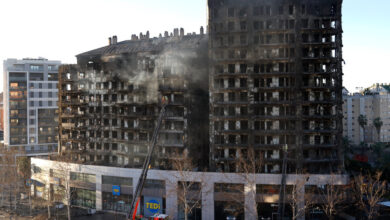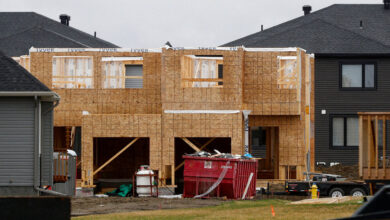
[ad_1]
The traditional village ball 18 minutes outside the city ended in the traditional way: young men fighting outside.
What made it different were the flashing knives.
Three young men were rushed to the hospital early in the morning on Nov. 19. One, the 16-year-old captain of a local rugby team, died en route from a stab wound to his heart.
What might have been considered a local tragedy for the residents of Romans-sur-Isère, a working-class city 60 miles south of Lyon, quickly became a national story for one reason: race. The victim was a white teenager from the countryside, while many of the suspects were of North African ancestry and from La Monnaie, a rough city neighborhood notorious for drug dealing.
Almost immediately, far-right supporters, politicians and the right-wing media pounced on the case as proof that France’s traditional values were under threat from immigrants, and their descendants, who they say have refused to assimilate.
Nourished by this interpretation, 50 to 100 ultraright nationalists later descended on the city to avenge what they characterized as an anti-white murder. Armed with iron bars and baseball bats, they chanted, “Islam get out of Europe.”
For others, it was the far right’s growing strength and audacity that posed the biggest threat to the country and their own safety. Many residents of La Monnaie said they now stayed at home, fearing they would be targeted for wearing hijabs or for their North African roots.
“The far right today wants to push us into a civil war,” Interior Minister Gérald Darmanin declared on national radio.
The events have left many residents of Romans-sur-Isère, a city that clings to its former glory as France’s luxury shoe manufacturing capital, in a state of numb bewilderment.
“The horror of it — you send your child to a party, and they return dead or murderers,” said Thomas Huriez, a city councilor.
“We are all restless and hypersensitive,” he said. “We are all a bit lost in it, but the majority, we want things to calm down and to know the truth.”
The truth will have to wait until the vast criminal investigation finishes. More than 100 gendarmes are on the case. Two days after the bloody scene, they swept in to arrest nine young men and teenage boys, seven of whom had fled 300 miles west to Toulouse. They face charges of murder and attempted murder in an organized gang. Several other suspects are still at large.
The ball was held in the sleepy nearby village of Crépol, population 530. Weekend balls are a tradition in villages across France, and some 400 people crowded into the stucco community center tucked down a thin road behind the supermarket.
As the party was winding down, a petty insult about a hairstyle triggered a fight that was taken outside. Brawls at the end of village balls are so common, local seniors recount them almost nostalgically — but this one quickly took violence to a shocking level.
A knife wound to Thomas Perotto, the youngest son of a restaurant owner, proved lethal.
Other details and motives remain murky. At the outset of the investigation, as the prosecutor tried to tame far-right conjecture raging on social media, he offered official reports. But after charges were officially brought, the investigation was handed over to two investigating judges, who have remained silent.
The official story, to date, comes from the first 100 or so witnesses interviewed, who told investigators that members of the small group from La Monnaie — reinforced by others who arrived in cars — threw rocks and metal fences and pulled out knives.
Nine of the scores of witnesses said they heard hostile comments toward “whites” during the fight.
Since then, investigators have conducted hundreds more interviews, according to the local prefect, Thierry Devimeux.
“We only have one side of the story,” said Mr. Devimeux, the top state official in the region. “I’m not sure that there weren’t equally ugly words in the other direction.”
In Crépol, however, many are still convinced the city boys came not to dance and talk to girls, but to attack white people.
Weeks after the confrontation, rain-soaked bouquets and burned-out candles decorated the entrances of the hall, which remained a sealed crime scene. One hand-painted sign summoned the local resistance movement to the Nazi occupiers. “Fight against the thugs,” it said.
“Two populations live in France, one of which must constantly flee the attacks of the other increasingly violent faction,” wrote Éric Zemmour, the head of France’s extreme-right party Reconquête. He reposted on social media a list of North-African sounding names, purporting them to be the suspects.
A week after the ball, the right-wing mayor of Romans-sur-Isère, Marie-Hélène Thoraval, declared that there were some 50 irredeemable “savages” in La Monnaie who, fueled by drugs and radicalization, represented a worrying trend across the country.
“The city of Romans crystallizes the national feeling of being fed up over this criminality,” said Ms. Thoraval, releasing a list of five local public buildings that had been burned down in recent years, including a community center and nursery.
“I just said and translated what’s been the reality,” she said in an interview. “And this truth, it hurts.”
She has been placed under police protection after recent death threats.
But her opponents on the City Council accuse her of cutting funding to local programs in La Monnaie since her election in 2014.
The closures include a neighborhood association building that had offered jobs to locals and after-school programs for young children.
In 2016, teachers published “a cry of alarm” about the services that had been stripped away.
Like suburbs around the country, La Monnaie’s subsidized apartment buildings went up after World War II to house workers for new factories. Over time, the factories shut, unemployment rose, and those who remained were increasingly poor immigrants.
Many buildings were felled and never replaced, leaving forlorn fields. The scars from burned cars dot the streets. Drug deals occur openly at night.
Locals agree there is a clutch of drug dealers and thugs who commit arson in La Monnaie. Mothers at the neighborhood’s busy Saturday market recounted worries that their children would get mixed up with them. But they did not consider them personally threatening, nor think of their neighborhood as dangerous. They described it as close-knit place where neighbors send over bowls of dinner.
They showed online photographs of some of the accused at the ball that night dancing. One of them was also stabbed.
“Stop saying these youth went there to attack. That’s not the truth. They went to have fun, and it ended in a brawl,” said Samira, a mother of four who withheld her last name out of fear, as her daughter was threatened after photographs of her with one of the accused circulated online.
Many residents of La Monnaie said they now feared being targeted by far-right supporters, who were only stopped from entering the neighborhood during their march by police officers in riot gear. Families of the accused received death threats online and delivered by mail. One mother gave up the lease of her home and moved away.
More than a dozen of the ultraright protesters were arrested; six were tried immediately and sent to prison for assaulting officers and taking part in a violent group.
“My daughter is so terrified, she didn’t send her children to school this week,” Ajela Idir, 67, a retired shoe factory worker shopping with her sisters, said in December.
Many said they felt stigmatized by the mayor’s comments, and they blamed her for inflaming the problems in their neighborhood, leading to delinquency.
“These guys were 5 or 10 years old when the mayor was elected,” said Salim Dlih, 42, who grew up in La Monnaie and had returned for a community gathering to protest the mayor’s words. “If she had kept the same programs that I had when I was young, if they had the same chance as I had, maybe they would be working as engineers at companies like me.”
He added, “Her hand was also on the knife.”
Sitting in a coffee shop in the city’s charming historic district, a few minutes away by car, Joseph Guinard, another city councilor, said he felt conflicted. His grandson was among those injured that night and he was among the nine witnesses who heard racist words against whites.
Mr. Guinard concurred that La Monnaie had experienced cuts. But poverty did not explain carrying a knife to a ball and stabbing someone, he said.
“Before I thought everyone was good. I found excuses easily. It’s more difficult now,” said Mr. Guinard, 68. “It’s not a question of investments or money. It’s a question of humanity.”
Aurelien Breeden contributed reporting from Paris, and Juliette Guéron-Gabrielle from Romans-sur-Isère, France.
Source link




